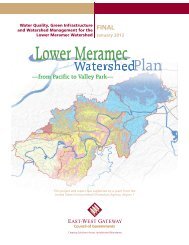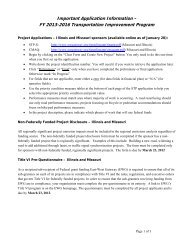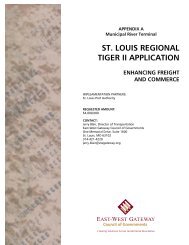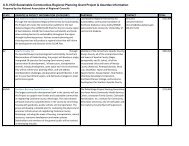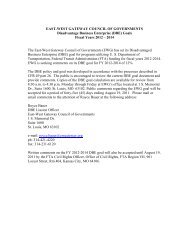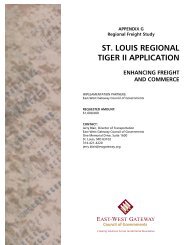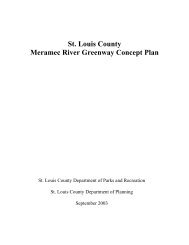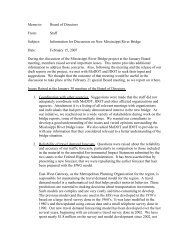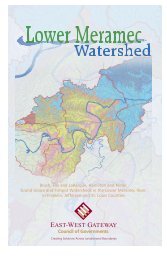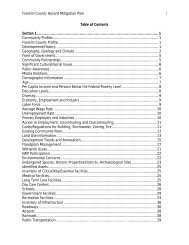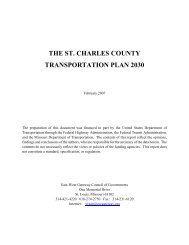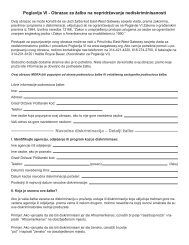Jefferson County - East-West Gateway Coordinating Council
Jefferson County - East-West Gateway Coordinating Council
Jefferson County - East-West Gateway Coordinating Council
Create successful ePaper yourself
Turn your PDF publications into a flip-book with our unique Google optimized e-Paper software.
70<br />
Characteristics<br />
<strong>Jefferson</strong> <strong>County</strong> – Section 2<br />
Snow can range from blizzard conditions to snow flurries and can accumulate to several<br />
inches, resulting in dangerous driving conditions. Ice conditions including sleet and<br />
freezing rain can result in roadways being covered in sheets of ice and ice jams resulting in<br />
flooding. Sleet usually bounces when hitting a surface and does not stick to objects;<br />
however, it can accumulate like snow and cause a hazard to motorists. Freezing rain is rain<br />
that falls onto a surface with a temperature below freezing; this causes it to freeze to<br />
surfaces, such as trees, cars, and roads, forming a glaze of ice. Even small accumulations of<br />
ice can cause a significant hazard. An ice storm occurs when freezing rain falls and freezes<br />
immediately on impact. Heavy accumulations of ice can bring down trees, electrical wires,<br />
telephone poles and lines, and communication towers. Communications and power can be<br />
disrupted for days while utility companies work to repair the extensive damage.<br />
Sometimes winter storms are accompanied by strong winds creating blizzard conditions<br />
with blinding wind-driven snow, severe drifting and dangerous wind chill. Strong winds<br />
with these intense storms and cold fronts can knock down trees, utility poles and power<br />
lines. Extreme cold often accompanies a winter storm or is left in its wake. Prolonged<br />
exposure to the cold can cause frostbite or hypothermia and become life-threatening.<br />
Infants and elderly people are most susceptible to extremely cold weather conditions. What<br />
constitutes extreme cold and its effect varies across different areas of the United States. In<br />
areas unaccustomed to winter weather, near freezing temperatures are considered<br />
"extreme cold." Freezing temperatures can cause severe damage to citrus fruit crops and<br />
other vegetation. Pipes may freeze and burst in homes that are poorly insulated or without<br />
heat. In the north, below zero temperatures may be considered as "extreme cold." Long<br />
cold spells can cause rivers to freeze, disrupting shipping, and Ice jams may form and lead<br />
to flooding.<br />
Heavy snow can immobilize a region and paralyze a city, stranding commuters, stopping<br />
the flow of supplies, and disrupting emergency and medical services. Accumulations of<br />
snow can collapse buildings and knock down trees and power lines. In rural areas, homes<br />
and farms may be isolated for days, and unprotected livestock may be lost. The cost of<br />
snow removal, repairing damages, and loss of business can have large economic impacts<br />
on cities and towns.<br />
Extreme cold temperatures are ranked based upon a wind chill chart that figures the<br />
temperature on how the wind and cold feel on exposed skin. As the wind increases, heat is<br />
carried away from the body at a faster rate, driving down the body temperature. Frostbite,<br />
hypothermia and death can result from winter weather. Seventy percent of snow injuries<br />
result from vehicle accidents, 25% occur in people getting caught in the weather. Cold<br />
injuries occur to 50% of people over 60 years old, 75% happen to males and 20% occur in<br />
the home.



